This activity is based on a popular activity designed to explain the process of pollination with a game, available at the Garden at School blog and with extra resources here. We adapted it to include the idea that flowers have evolved to use the preferences and abilities of different groups of pollinators to attract them and to better “use” them as pollinators.
The resulting activity is a game where children act out the process of pollination dressed as different species of flowers or different types of pollinators. If you are not a pollination biologist and are interested in the science behind this activity, you can read a summary in the Wikipedia page or a scientific review here.
The protocol below is suited for children in year 6 (10 year-olds) but it can be easily adapted to different ages.
Student Prior Knowledge:
According to UK’s National Curriculum for Key Stage 2, children in Year 6 should be familiar with:
- Reproduction in plants
- Adaptation to environments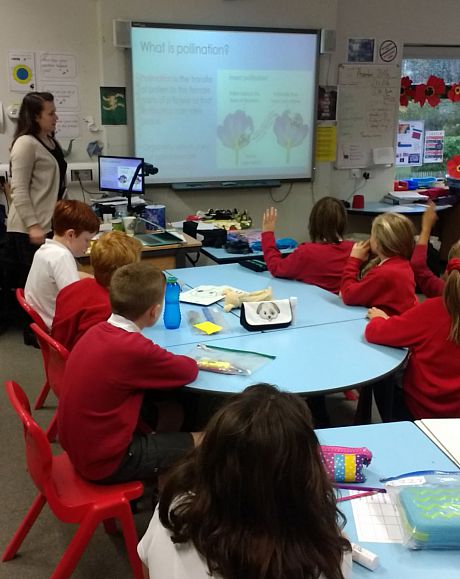
Session aims:
- Recap pollination and pollinators
- Introduce the topic of floral adaptation to different pollinators
- Carry out a dynamic activity demonstrating pollination and floral adaptation
- Optional: discuss the implications of declining pollinator populations and ways to help
Running Time:
Approx. 55 minutes including set up and pack down so can fit into a 1-hour lesson slot.
- Set up: 5 minutes
- Introductory slides: 15 minutes
- Activity: 15 minutes
- Concluding slides: 5 minutes
- Feedback questions: 10 minutes
- Pack down: 5 minutes
Materials:
(here is a list of materials)
After a short introduction with colourful slides, all children will dress up to play the pollination game. For a group of around 30 children you will need materials for around six flowers. Each "flower" will need a headdress, a nectar container, and a sticky armband where "pollen" (pompoms) will adhere to. The sticky armbands can be made with double sided tape on them. Children wearing red flower hats are to represent bird pollinated flowers; they will also have tall thin glasses, like champagne flutes, filled with fruit juice (=”nectar”) to simulate the tubular shape often found in bird-pollinated flowers. Yellow, blue or purple flowers are to mimic bee-pollinated flowers, with nectar in smaller cups or beakers to represent a more accessible nectar reward. White flowers represent bat-pollinated flowers and they are given paper bowls of nectar to simulate the broader and sturdy nature of bat-pollinated flowers.
The remaining children will be pollinators, ideally wearing bird and bat marks, and bee antennae. Bird and bee pollinators will have straws for feeding and bats will have plastic spoons as tongues. They all wear sticky armbands as well.
Activity:
- In the classroom, set up tables at the back of the room with the eight bowls of pollen (pompoms) and corresponding cups of nectar (fruit juice). Red pompoms should be with the hummingbird glasses (plastic champagne flutes), yellow pompoms with the bee glasses (small plastic cups) and white pompoms with the bat nectar bowls (paper bowls).
- Begin with a short introductory presentation, with slides recapping the concept of pollination and pollinators. Explain also the concept of floral adaptation, using examples of bee, bat and hummingbird pollinated flowers. Mention how the different animals have different perception abilities that plants use to attract them. Don´t forget to stress that, even though some flowers have evolved to be best pollinated by a group of animals, this relationship is rarely exclusive. Pollination interactions are, in the vast majority of cases, not specialized mutualisms.
- Explain the outline of the activity to the children while doing brief a demonstration with another adult so that the children are able to visually see what they will be doing. This includes putting on a costume, helping a partner put on their sticky armband and the process of pollen transfer in exchange for nectar.
- Now provide each participant with a sticky armband.This will take a few minutes sohave the children help each other to finish faster.
- Assign some children to be flowers and ask them to stand behind their corresponding pollen bowls and nectar container.
- Assign the remaining children to a pollinator group (bats, bees or birds) and provide them with their corresponding costume.
- Once the children have all their necessary equipment the activity can begin. Pollinators must queue up at the flowers for their pollinator group in order to drink nectar and receive pollen.They then need to queue up at the other flower to drink some more nectar and stick their pollen grain to the flower before collecting more.Let this run until the flowers are covered in plenty of pollen.
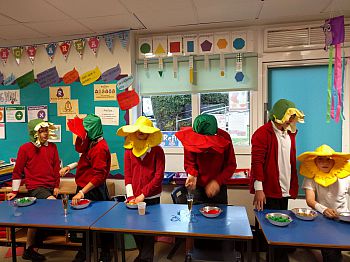
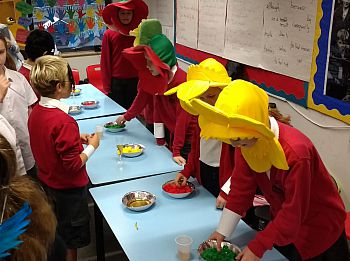
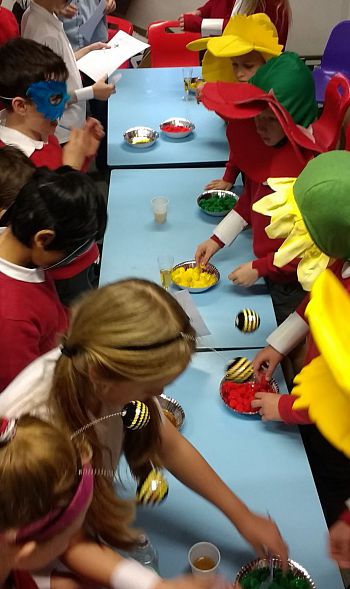
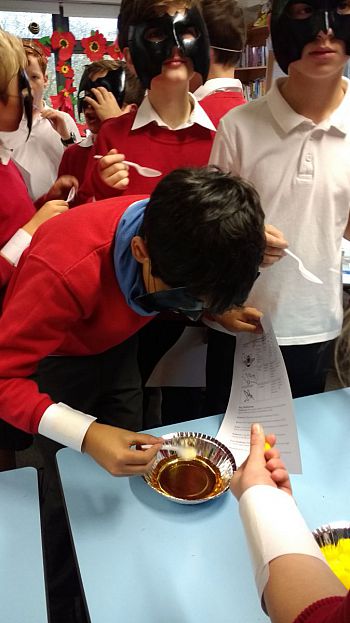
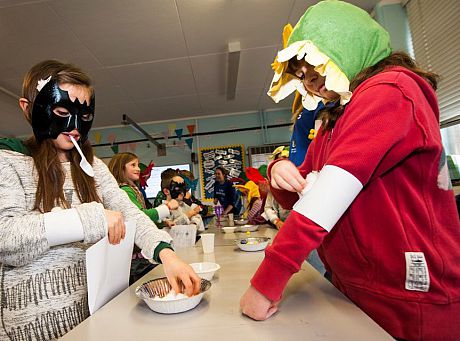
- Once the activity is completed ask the children to sit back in their seats or at front of classroom. Return to the PowerPoint slides to recap on what you have just done and ask a few reflective questions. For example:
- Why are some pollinators better at pollinating some of the flowers?
- What do you think would happen if one pollinator group disappeared altogether?
9. If you have time, lead into how this is actually happening to pollinators (i.e. bees) in many parts of the world and why this is a problem for both wild and crop plants. Use examples of crops they know such as strawberries and apples. Discuss what the children can do in order to help the bees; for example, planting bee-friendly plants and building bee hotels.
Suggestions for Assessment:
Finish off the session by asking a series of multiple-choice questions. Find a creative and easy way of recording the answers, such as filling up a form or using Turning Point software. We suggest asking two or three content based questions to find out how much they learned, and two feedback questions to assess if they enjoyed the activity.



